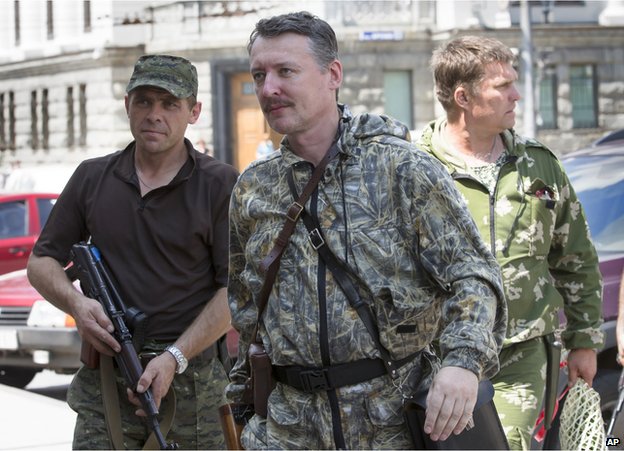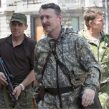
Russia’s Donetsk Proxies Anticipate Ukrainian Siege
Publication: Eurasia Daily Monitor Volume: 11 Issue: 149
By:

The newly-installed “prime minister of the Donetsk people’s republic (DPR),” Aleksandr Zakharchenko, was apparently asked to convey a reassuring message to Russia’s public in anticipation of a Ukrainian siege of the city of Donetsk. Following six weeks of military reverses and shrinkage of “DPR’s” territory, Zakharchenko told Russian state television that Donetsk forces would switch to flexible tactics, combining defensive battles with counter-attacks. “We are capable of inflicting big losses on the enemy,” Zakharchenko (himself a paramilitary “brigade” commander until a few days ago) averred. He claimed that 45 armored vehicles seized from the Ukrainian army in recent days would spearhead the planned counter-offensive from Donetsk (Russian TV Channel One, August 11; see EDM, August 12).
More pessimistically, the head of “DPR’s representation” in Moscow, Andrei Rodkin, admits that the defense of Donetsk may fail; and in that case, “the armed conflict in Ukraine could turn into guerrilla warfare” (TRK Peterburg, August 4).
Zakharchenko’s extra 45 armored vehicles are far more likely to have been supplied by Russia, rather than captured by beleaguered Donetsk paramilitaries from a Ukrainian army that has the momentum on its side. That momentum, however, has demanded a high cost in battle casualties, and has slowed down as Ukrainian forces approach the Donetsk urban agglomeration.
The undefended border allows Russia to supply secessionist forces almost at will with arms and ammunition, vehicles, instructors and fresh fighters, aerial intelligence, and artillery fire targeting Ukrainian forces from Russian territory.
Intelligence collected by the United States, the North Atlantic Treaty Organization (NATO) and Ukraine has amply documented those cross-border activities. The Organization for Security and Cooperation in Europe (OSCE) maintains a token presence of observers on that border. However, Moscow has used its right of veto to minimize that OSCE group’s mandate into near-irrelevancy. The OSCE cannot detect, report, or stop Russia’s cross-border military activities that the other parties can and do detect and report. Ukrainian units attempting to protect the border are constantly cross-fired upon by artillery from Russian territory and by secessionist forces from the rear.
Marking four months since the start of the anti-terrorist operation, Ukraine’s National Security and Defense Council (NSDC) reports combat casualties at 568 killed and 1,120 wounded, as well as 83,000 internally displaced civilians. Daily combat casualty rates seem to have increased recently (Interfax-Ukraine, August 11). Some 50,000 personnel are currently taking part in the operation to liberate Ukraine’s Donetsk and Luhansk provinces. The two eponymous cities are not completely encircled yet.
Donetsk is by far the larger nut to crack (see EDM, July 14, 15, 30, August 1). “DPR” forces are generally estimated at 15,000 to 20,000. Leaders continue complaining about the poor response to their enlistment efforts. This indicates that the proportion of fighters from Russia must be significantly higher than commonly assumed (and understated in the vague term “pro-Russian forces”). According to the “DPR mobilization directorate” head, Pavel Gubarev (who also heads the local “Novorossiya party”), only 2,300 Donbas residents enlisted in the force, from the start of “mobilization” in mid-May until August 1 (RIA Novosti, August 1).
“DPR” leaders aspire to turn at least parts of their paramilitary force into a “regular army,” with service branches and a unified chain of command. The new “prime minister” Zakharchenko has reaffirmed this goal in his inaugural speeches. He calls for turning the city of Donetsk into “one big camp” in anticipation of a Ukrainian siege, and defending the city “like Stalingrad” (DPR press service, August 9, 10).
The commander, Colonel Igor Girkin/Strelkov, has introduced a state of siege, including a curfew and a requisitioning system, in the city of Donetsk and adjacent districts (rayons), effective from July 30. Unit commanders are authorized to requisition transportation vehicles, construction materials, fuel, food, and medicine from public entities and individuals, “against a receipt.” Girkin/Strelkov introduced these measures on his authority, by military order as “commander of the popular insurgency [opolchenie] and of the Donetsk city defense headquarters” (DPR press service, July 31). He favors (as does Zakharchenko—see above) a “Stalingrad”-type defense in the city of Donetsk.
Meanwhile, unity of command is precarious. Girkin/Strelkov has achieved renown in Russia, and has collected multiple titles in the “DPR” since April: commander in chief, “defense minister,” “security council chief,” Donetsk city commandant. But some of these titles and powers are contested, and his authority is questioned by several Russian commanders in the field.
Girkin/Strelkov wields direct authority over his “Slovyansk brigade,” as several other commanders do over their units with their specific zones of responsibility. They operate autonomously, basically coordinating with Girkin/Strelkov, taking orders from him conditionally on a case by case basis, and conducting joint operations ad hoc.
Oleksandr Boroday, the Muscovite “DPR prime minister” until August 8, created a “commanders’ council” that meets from time to time in Donetsk for coordination purposes.
The main units (some billed as “brigades” irrespective of manpower numbers) include:
- “Slovyansk brigade” under Girkin/Strelkov (see above);
- “Oplot” (Bulwark), some 1,000 strong, partly comprised of street fighters trained by the “Oplot Fight Club.” The commander, Aleksandr Zakharchenko (see above), was that fight club’s chief until recently, and became “DPR prime minister” on August 8 (see EDM, August 12).
- “Vostok” (East) battalion, a heterogenous unit comprised of defectors from the Security Service of Ukraine’s (SBU) Donetsk unit (dissolved after the regime change in Kyiv), North Caucasus fighters, and some other elements. The commander, Major Aleksandr Khodakovsky, is double-hatted as “DPR state security minister,” and maintains a stronghold of his own in Makyivka, outside Donetsk.
- Horlivka unit, based in that town outside Donetsk, decimated by Ukrainian forces besieging Horlivka since mid-July. The unit’s commander, Lieutenant-Colonel Igor Bezler, absconded to Russia during the siege, leaving his deputy “Botsman” to lead the surviving fighters. These are said to have mined Horlivka’s ammonia plants, rendering a Ukrainian storming of the town too hazardous to contemplate.
- “Prizrak” (Ghost) battalion, technically a part of the Luhansk “people’s republic’s” forces (smaller than “DPR’s”). Nevertheless the Prizrak commander, Aleksey Mozgovoy, closely cooperates with Girkin/Strelkov, whom he is personally loyal to. Should Donetsk and Luhansk fall, Mozgovoy promises to conduct guerrilla warfare “in Novorossiya’s vast territories” (Pravda.ru TV, Den TV, via Russkaya Vesna, August 7 and 8).
“DPR interior ministry” and “state security ministry” units are currently being formed with a view to maintaining “stability” in Donetsk during a foreseeable siege.




